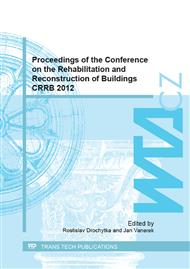[1]
M.E. Ozkok, R. Ozcelik, B. Binici, Performance Comparisons of External Strengthening Methods for Deficient RC Frames, ATC&SEI 2009 Conference on Improving the Seismic Performance of Existing Buildings and Other Structures (2009)
DOI: 10.1061/41084(364)84
Google Scholar
[2]
C.S. Girgin, S.İ. Mısır, Ö. Özçelik, S. Kahraman, T. Baran, Kolon Kiriş Birleşim Bölgelerinin Güçlendirilmesine Yönelik Çalışmalar, IMO İzmir Şubesi Bulteni, 154 (2010) pp.28-31. (Turkish)
Google Scholar
[3]
T. El-Amoury, A. Ghobarah, Seismic Rehabilitation of Beam–Column Joint Using GFRP Sheets, Engineering Structures, 24 (2002) 1397-1407
DOI: 10.1016/s0141-0296(02)00081-0
Google Scholar
[4]
G. E. Thermou, A. S. Elnashai, Seismic Retrofit Schemes for RC Structures and Local–Global Consequences. Earthquake Engineering and Structural Dynamics, 8 (2006) 1-15.
DOI: 10.1002/pse.208
Google Scholar
[5]
A.D.G. Tsonos, Performance Enhancement of R/C Building Columns and Beam_Column Joints Through Shotcrete Jacketing, Engineering Structures, 31 (2010) 726-740.
DOI: 10.1016/j.engstruct.2009.12.001
Google Scholar
[6]
A. Pimanmas, P. Chaimahawan, Cyclic Shear Resistance of Expanded Beam-Column Joint, Procedia Engineering, 14 (2011) 1292-1299.
DOI: 10.1016/j.proeng.2011.07.162
Google Scholar
[7]
A. Pimanmas, P. Chaimahawan, Shear Strength of Beam-Column Joint with Enlarged Joint Area, Engineering Structures, 32 (2010) 2529-2545.
DOI: 10.1016/j.engstruct.2010.04.021
Google Scholar
[8]
S. Pampanin, Controversial Aspects in Seismic Assessment and Retrofit of Structure in Modern Times: Understanding and Implementing Lessons from Ancient Heritage. Bulletin of New Zealand Society for Earthquake Engineering, 39 (2006) 120-132.
DOI: 10.5459/bnzsee.39.2.120-133
Google Scholar
[9]
M. K. Sharbatdar, A. Kheyroddin, E. Emami, Cyclic Performance of Retrofitted Reinforced Concrete Beam–Column Joints Using Steel Prop. Construction and Building Materials, 36 (2012) 287-294.
DOI: 10.1016/j.conbuildmat.2012.04.115
Google Scholar
[10]
P. A. Calderón, J. M. Adam, S. Ivorra, F. J. Pallarés, E. Giménez, Design Strength Of Axially Loaded RC Columns Strengthened By Steel Caging. Materials and Design, 30 (2009) 4069-4080.
DOI: 10.1016/j.matdes.2009.05.014
Google Scholar
[11]
STK Construction and Engineering Company, Rehabilitation Photograph (2005)
Google Scholar
[12]
M. Ehsani, Seismic Retrofit of McKinley Tower, Structure Magazine, (2007) 35-37
Google Scholar
[13]
I. Bedirhanoğlu, The Behavior of Reinforced Concrete Members with Low Strength Concrete Under Earthquake Loads: An Investigation and Improvement. Ph. D. thesis, Istanbul Technical University, Istanbul, Turkey, 2009, 700 (Turkish)
Google Scholar
[14]
I. Bedirhanoğlu, A. Ilki, S. Pujol, N. Kumbasar, Seismic Behavior of Joints Built with Plain Bars and Low Strength Concrete. ACI Structural J. 107 (2010) 300-310.
DOI: 10.14359/51663695
Google Scholar
[15]
A. Sharmaa, R. Eligehausen, G.R. Reddya, A New Model To Simulate Joint Shear Behavior Of Poorly Detailed Beam–Column Connections In RC Structures Under Seismic Loads, Part I: Exterior Joints. Engineering Structures, 33 (2011) 1034-1051.
DOI: 10.1016/j.engstruct.2010.12.026
Google Scholar
[16]
A. Ghobarah, A. Biddah, M. Mahgoub, Rehabilitation of Reinforced Concrete Columns Using Corrugated Steel Jacketing. Journal of Earthquake Engineering, 1 (1997) 651-673.
DOI: 10.1080/13632469708962382
Google Scholar
[17]
A. Ghobarah, A. Said, Seismic Rehabilitation of Beam Column Joints Using FRP Laminates. Journal of Earthquake Engineering, 5 (2001) 113-129.
DOI: 10.1080/13632460109350388
Google Scholar
[18]
G. Kotsovou, H. Mouzakis, Exterior RC Beam-Column Joints: New Design Approach. Engineering Structures, 41 (2012) 307-319.
DOI: 10.1016/j.engstruct.2012.03.049
Google Scholar
[19]
The Ministry of Public Works and Settlement Turkish Code for Buildings in Seismic Zones. Ankara, Turkey (2007)
Google Scholar
[20]
S. Sasmal, B. Novák, K. Ramanjaneyulu, Numerical Analysis Of Fiber Composite-Steel Plate Upgraded Beam–Column Sub-Assemblages Under Cyclic Loading. Composite Structures, 93 (2011) 599-610.
DOI: 10.1016/j.compstruct.2010.08.019
Google Scholar
[21]
W.K. Kam, S. Pampanin, Experimental and Numerical Validation of Selective Weakening Retrofit for Existing Non-Ductile R.C. Frames, Session: S7-2 Paper.1585 (2009)
DOI: 10.1061/41084(364)65
Google Scholar


